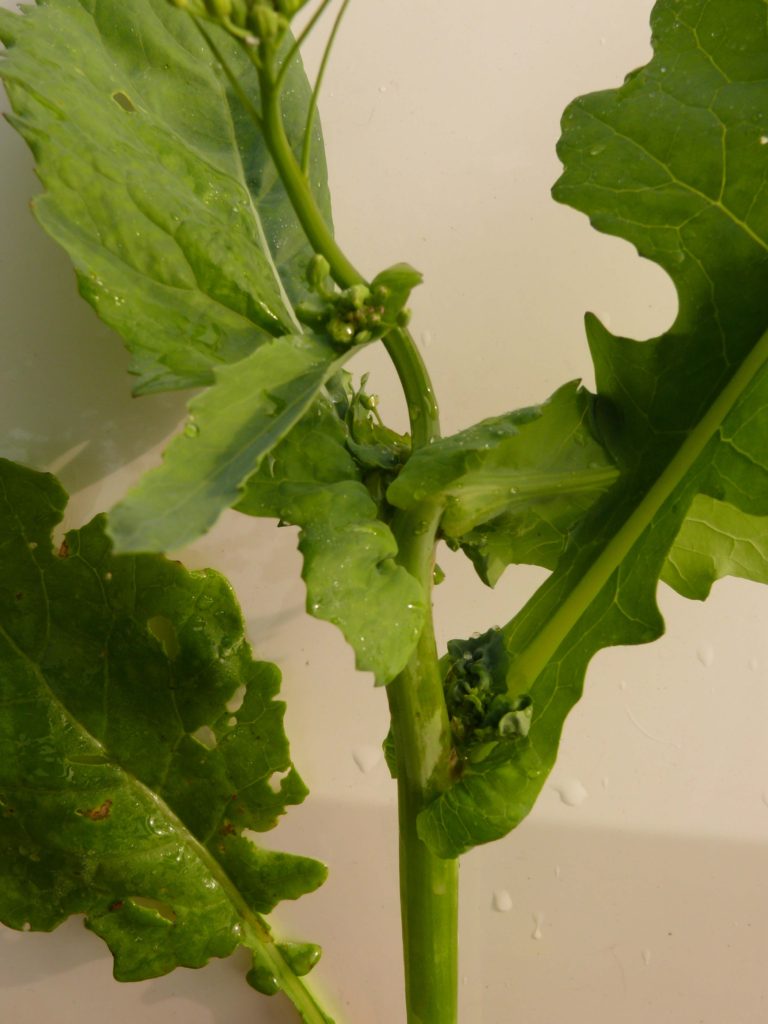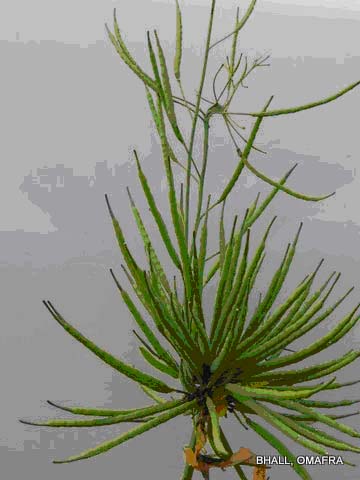Synopsis
Canola is advancing rapidly with April planted canola now bolting to 70% flower stage. Some canola stands are thin and uneven in growth which has growers questioning need or timing for fungicide. The biggest risk factors for sclerotinia are adequate soil moisture, rainfall during flowering, 48-72 hours of wetness in canopy for infection to occur and a dense canopy. Cabbage seedpod weevil is at threshold (2-4 per sweep) in a number of early flowering canola fields.
Emerging Issues
Cabbage Seedpod Weevil (CSPW)
Cabbage seedpod weevil can be found in canola that has started to bolt to bud stage. Weevil migration into canola begins at bud stage and peaks at early to mid flowering stage.
Scouting should focus on the adults (4mm long), since only the adults can be controlled. Scout on warm, sunny days when weevils are more active. Weevil adults are easiest to locate on the uppermost flower bud cluster. The presence of Finches in the field is sign that weevils are also in the field.
It is important not to spray too soon, as the weevil will typically continue to invade fields for 7 – 10 days after the first flowers open. A sweep net is the only practical way to determine the need to spray. If there are 2-4 weevils per sweep when the crop is in the early bloom stages (10 to 20% bloom stage, 2-4 days after flowering starts) control is necessary. Spraying at this time will allow the weevils enough time to move into the crop, while still early enough to prevent them from laying any significant number of eggs in pods. Weevils begin laying eggs in pods that are 3 cm (1.25”) long. Matador & Silencer are the only insecticide registered for control. Decis is registered in the western Canadafor CSPW. Spray at dusk is best timing or dawn to minimize the risk of bee kills. Notify local beekeepers in your area. Do not apply when bees are foraging. The larvae cost the greatest damage, consuming 3-5 seeds. Holes created in pods can also be source of fungal infection if conditions are wet
Tarnished plant bugs will also flourish in hot, dry weather and can cause problems with canola crops. Sweep net swipes will also provide information for monitoring for tarnished plant bugs and control is also provided by Matador/Silencer or Decis. The threshold for control is 2 per sweep after pedal fall.
Swede Midge
Swede midge development is 2 weeks ahead of normal, and is of concern in canola fields that have not bolted. Populations have increased this week as the second generation emerges. Heat and rain triggers Swede midge emergence. The adults are very tiny (1-2 mm) and can only be detected using Jackson traps. Swede midge adults lay eggs on growing point in canola, and developing larvae mine into the growing point causing malformed growth. In counties know to have the pest; canola that has not bolted is at the greatest risk. Research at University of Guelph showed that protecting the bud stage with Matador (or equivalent product) or Decis just prior to stem elongation has the best opportunity to protect plants long enough to allow them to bolt. No products are registered in canola for Swede midge.


Apply Fungicides Early to Beat Sclerotinia (White mould)
The clear message is that growers need to apply fungicides early before sclerotinia gets established. Fungicides only offer protectant activity and timing is at 20 – 50% flower stage with optimum being 20 -30% flower when there is near maximum number of flowers open and before pedal drop.
Predicting the occurrence of severe sclerotinia is difficult but good soil moisture leading up to flowering and showery weather coincides with inoculums production.
High risk conditions:
- Good soil moisture
- Rainfall at flowering creating high moisture conditions in canola canopy. Spores are spread easily long distances by wind Infected petals which drop and stick to wet stems and leaves are the food source for sclerotinia spores. Petal stick is favoured by light rains and heavy dews, whereas heavy rains will wash pedals off.
- Moderate temperatures (220 C) and humidity in the canopy for 2-3 days in the canopy are important for the fungus to gain a foot hold. Heavy overnight dews aid this.
- Dense canola canopy
A thin canopy or temperatures of over 280 C reduce risk of infection. The wide range in stages of the crop this year means it is important to assess each field on its own and for the weather at the time. In some fields, there is considerable variation in canola plant stage, which will present challenge in timing fungicide application and make control more difficult.
It is important not to apply too early. The goal with a sclerotinia fungicide is to achieve maximum flower petal coverage. Petals are an essential part of the infection process, providing nutrients for sclerotinia spores to germinate. Last year we had a lot of wet weather towards the end of flowering when early fungicide timings would have run out. Fungicides provide 10 -14 days of protection.
Products Registered: Include Proline (Bayer CropScience), Astound (Syngenta), Vertisan (DuPont), Quash (Nufarm), Serenade (UAP), Lance (BASF). Lance. Apply Proline only once per year. A second application of Lance may be made 7-14 days later if weather conditions are favourable for sclerotinia.
Keep water volumes up as good coverage is important to cover as many flower pedals as possible.
Identification of Flowering Stage of Canola
|
% Flowering Stage |
Number of Open Flowers on Main Stem |
Time from First Flower Days (approximate) |
|
10 |
At least 10 |
2 – 4 days |
|
20 |
14 – 16 |
5 – 6 days |
|
30 % |
20 Petal drop evident and 1st pods visible |
7 – 8 days |
|
50% ( Maximum Bloom) |
20+ flowers
|
10 -14 days |
Pictorial Guide to flowering stage is available from Bayer CropScience or on line at Ontario Canola Growers website http://www.ontariocanolagrowers.ca/grower_info.html
